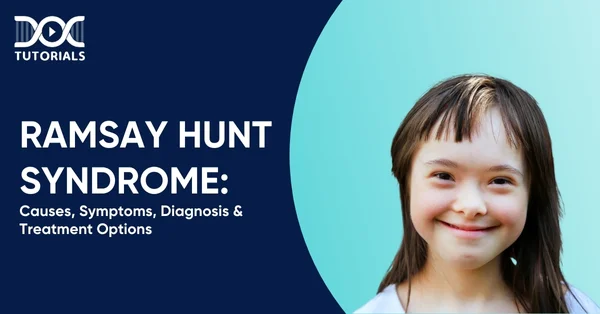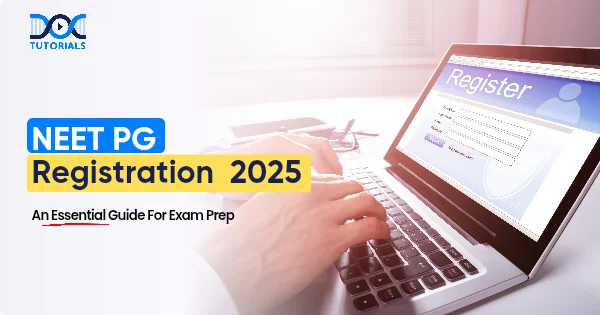Ramsay Hunt Syndrome | Causes, Symptoms, Diagnosis, & Treatment

Ramsay Hunt syndrome is one of the conditions that can lead to a peculiar combination of symptoms. Such symptoms can involve facial paralysis and painful rashes over the face, mouth, and ears. Although it is not a common condition, it is important to learn about it in detail, especially if you are preparing for the NEET PG exam.
Continue reading to understand more about Ramsay Hunt syndrome, its causes, symptoms, diagnosis, and treatment options.
What is Ramsay Hunt Syndrome?
Ramsay Hunt syndrome is a nerve disorder that develops from the reactivation of the “varicella-zoster virus” (the same virus that causes chickenpox and shingles) in the facial nerve ganglion. The condition is rare, affecting less than 1% of those with varicella-zoster disease, which affects the facial nerve, causing this syndrome.
It is also known as herpes zoster oticus, which causes a painful blistering rash over one of the ears and paralyses the muscles of the face on the same side. The typical presentation is a triad of unilateral facial weakness, intense ear pain, and a vesicular rash. Symptoms may, however, differ.
Facial weakness can show up ahead of the rash, or there can be no rash at all (a variant called “herpes zoster sine herpete”). In this regard, timely diagnosis and therapy are valuable factors. Thus, starting treatment within 72 hours after the manifestation of the symptoms significantly increases the likelihood of a cure.
What Causes Ramsay Hunt Syndrome?
Ramsay Hunt syndrome is caused when a dormant varicella-zoster virus (VZV) revives and affects the facial nerve (cranial nerve VII) within the ear. Following an individual recovering from chickenpox, VZV may stay in a hidden form in nerve cells.
Many years later, it can recur and trigger a shingles outbreak. When it affects the facial nerve, it causes the symptoms of Ramsay Hunt syndrome.
What are the Risk Factors of Ramsay Hunt Syndrome?
The risk factors of this syndrome include:
- Prior VZV Infection: Any person who has suffered from chicken pox or shingles is a carrier of latent VZV and can develop Ramsay Hunt syndrome in case of a virus recurrence.
- Age: It develops most frequently among older people (usually over the age of 60). It is relatively less likely to affect younger individuals and children.
- Weakened Immunity: VZV reactivation is triggered by conditions or treatments that suppress the immune system, including stress, steroid therapy, chemotherapy or HIV (human immunodeficiency virus).
- Lack of vaccination: People who have not received any chickenpox or shingles vaccination are at higher risk. The risk of infection and reactivation is reduced significantly through vaccination.
- Non-Contagious Nature: Ramsay Hunt syndrome does not transmit itself from person to person. The virus present in the rash is, however, contagious: a person who has never had chickenpox (or the vaccine) can develop chickenpox by direct contact with the blisters.
Until the rash blisters are crusted, avoid close contact with people who are vulnerable (such as babies or those who are not vaccinated).
What are the Symptoms of Ramsay Hunt syndrome?
Common symptoms of Ramsay Hunt syndrome include:
- Burning blistering rash on a single ear or the surrounding area
- Weakness or paralysis of one side of the face (drooping of the mouth, not able to close the eye)
- Severe pain in the ears on that side
- Changes in hearing, e.g. hearing loss or ringing (tinnitus) in the affected ear
- Vertigo (dizziness) occurs when the vestibular nerve is affected
- Other symptoms may include loss of taste on one side of the tongue, dry mouth or eyes, as well as numbness in the face
All these symptoms mostly happen on one side of the face. The rash and paralysis usually show up concurrently, although there are instances when one precedes the other. In the zoster sine herpete form, there is no rash, which complicates diagnosis.
What is the Diagnosis of Ramsay Hunt Syndrome?
The diagnosis is usually made on the basis of the history and physical examination by the doctors. The occurrence of a rash like shingles in the ear region, in addition to facial paralysis, normally clinches the diagnosis.
VZV infection can be confirmed by testing a sample of fluid in the blisters. Other tests (blood VZV titers, nerve conduction studies, and magnetic resonance imaging) are rarely needed unless the image is unclear.
What are the Treatment Options for Ramsay Hunt Syndrome?
Ramsay Hunt syndrome treatment is most effective when initiated in the first 72 hours after symptoms start. The principal therapies are:
- Antiviral Medications: The virus is suppressed with Acyclovir, valacyclovir, or famciclovir. Oral antivirals are generally administered in high doses and prescribed to last durations of 7-10 days, although specialists might prolong treatment in case of a heavy infection.
- Corticosteroids: Prednisone (or equivalent) is prescribed in a high-dose course to alleviate facial nerve inflammation. Normal treatment is prednisone of ~1 mg/kg/day (usually up to 60 mg), tapering over days or weeks.
- Pain Relief: Over-the-counter painkillers like ibuprofen or acetaminophen are used. Severe painful conditions might warrant prescription drugs (such as opioids). In case of nerve pain (postherpetic neuralgia), neuropathic drugs (gabapentin or tricyclic antidepressant ) may be added.
- Vertigo Control: In cases where there is dizziness, drugs such as meclizine (an antihistamine) or taking a benzodiazepine (diazepam) can help.
- Eye Care: When the eyelid cannot close due to facial weakness, the cornea should be guarded. Take moisturising eye drops during the day and lubricating ointment at night. To stop drying and injury, you may tape the eyelid shut at bedtime or wear an eye patch.
- Supportive Care: Rest can be assisted by a cool or warm compress to the rash, which may control discomfort. Wash the rash with clean water and use any ointments or dressings that the doctor advises.
Most individuals start recovering in several days to weeks with early treatment. On average, 70% of patients recover at least partially, with full or near facial recovery when early treatment is initiated. Nevertheless, weeks or months may be required before complete recovery.
FAQs About Ramsay Hunt Syndrome
- Can Ramsay Hunt syndrome be prevented?
Yes. The most important preventive measure is vaccination. Risk is greatly reduced by vaccination against chickenpox (in children) and shingles (in adults aged 50 years and above). Viral reactivation may also be prevented by remaining healthy and stress-free. - Is Ramsay Hunt syndrome contagious?
No, it is not a syndrome that is contagious. However, its rash fluid can transfer the chickenpox virus (VZV) to unvaccinated people. Avoid contact with babies, pregnant women, and immunocompromised individuals until the rash goes away. - How serious is Ramsay Hunt syndrome?
It is serious, but most recover well when treated early. Approximately 70% of the patients achieve full or near full facial re-functioning. The longer the treatment is delayed, the higher the chances that the face might suffer permanent weakness or nerve pain. - What’s the difference between Ramsay Hunt syndrome and Bell’s palsy?
Both of these conditions lead to facial paralysis. Ramsay Hunt syndrome, however, most typically involves a painful rash on the ear, whereas Bell’s palsy does not. In many cases, RHS can be worse and requires early antiviral therapy. - What should I do if I suspect I have Ramsay Hunt syndrome?
You must immediately call a doctor. Prescription of antiviral and steroid treatment within 72 hours improves the recovery process. Meanwhile, bandage your eye when it fails to close and treat the pain using medicine.
Conclusion
Ramsay Hunt syndrome is a rare but threatening condition. Treating and diagnosing it early is necessary to prevent permanent nerve damage, pain, or deafness. Regardless of whether it manifests with a rash or not, beginning treatment within 72 hours significantly increases the chances.
For NEET PG students, platforms like DocTutorials are designed to support your learning with concise video lectures, focused quick revision programs (QRPs), and well-structured high-yield notes tailored for both exam success and clinical readiness.
Join DocTutorials’ NEET PG course to excel in your medical exam!
Latest Blogs
-

NEET SS Exam 2024: Analysis, Key Dates, Counselling
The NEET SS 2024 exam kicked off on March 29, 2025. Over two days and two slots, candidates across 13…
-

NEET PG Registration 2025: An Essential Guide For Exam Prep
The NEET PG registration, which is conducted online, is a crucial step in the exam process. Filling out the NEET…
-

NEET PG Syllabus 2026: A Must-Have Complete Guide for Exam Success
The NEET PG Syllabus acts as one of the foundation stones for aspiring postgraduate medical students like you who are…




